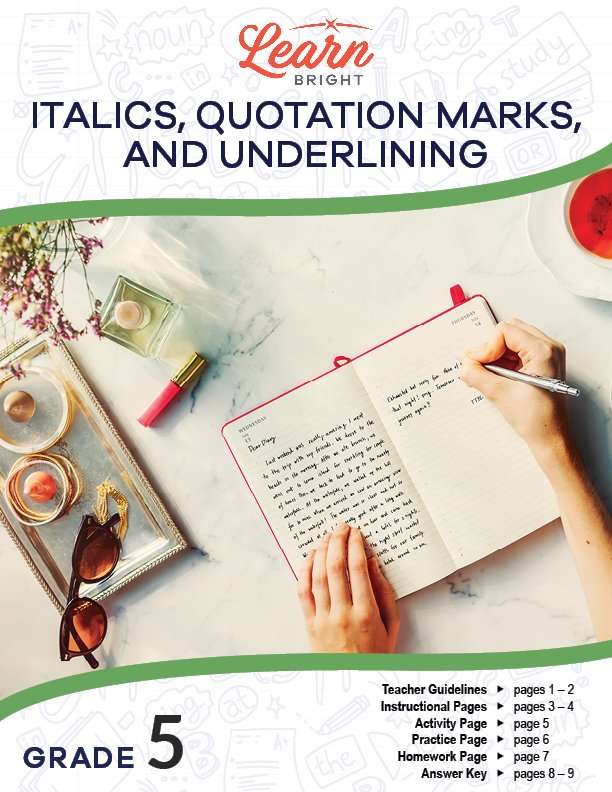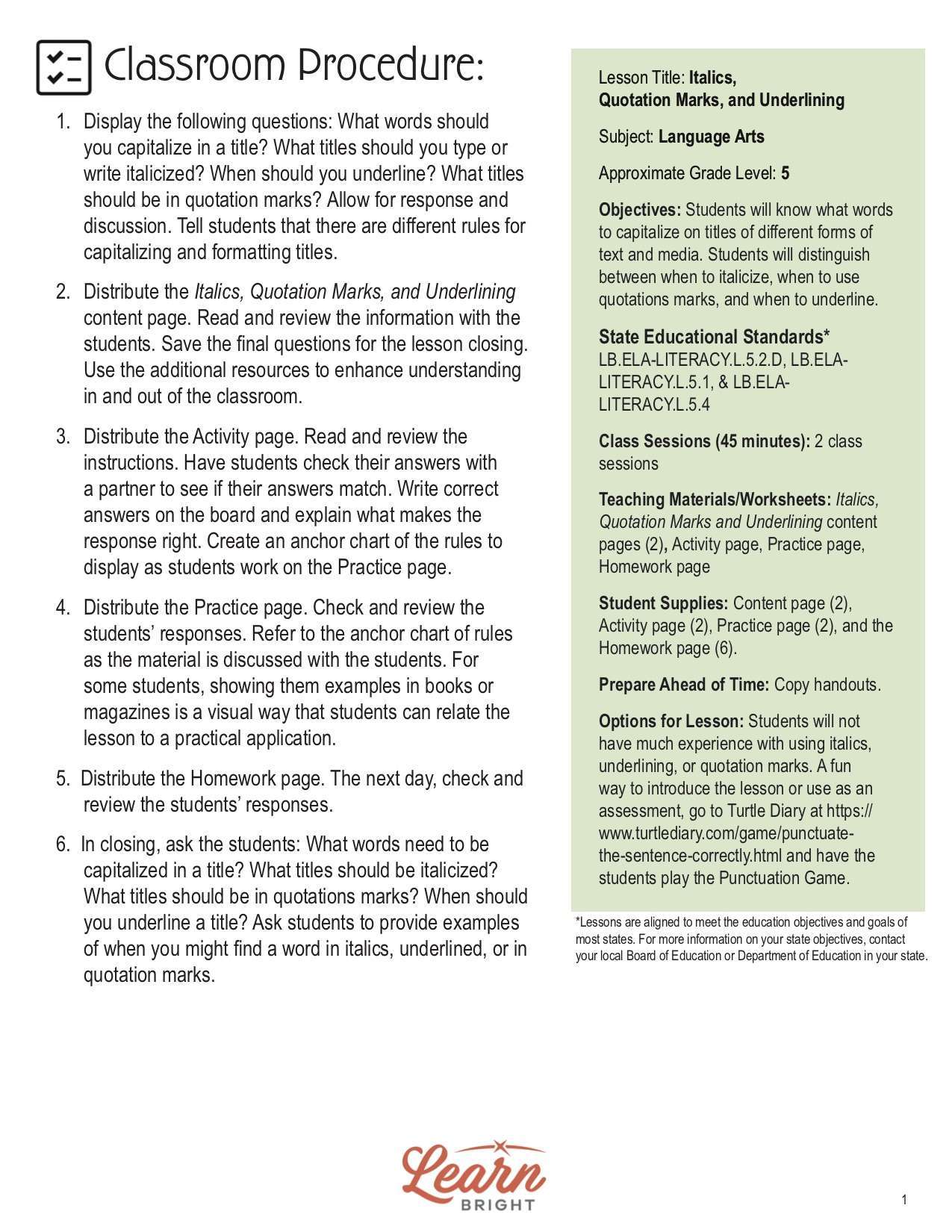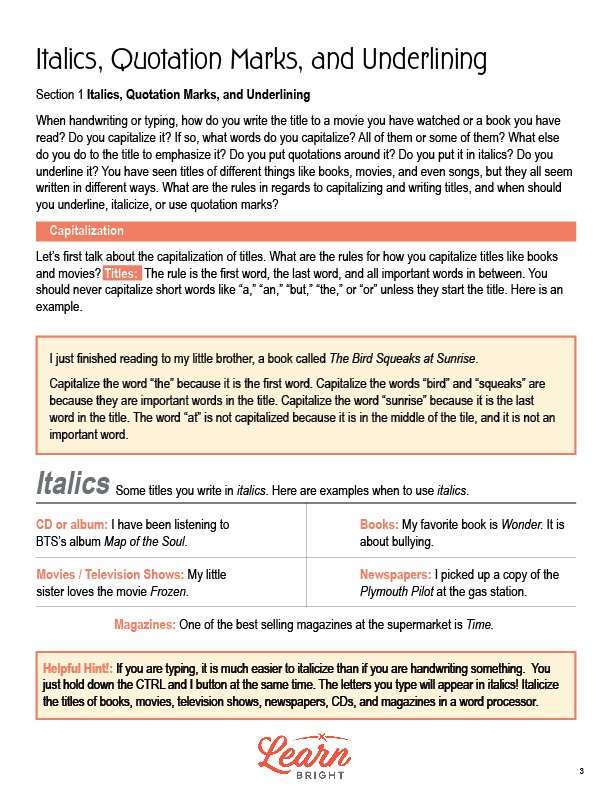Description
What our Italics, Quotation Marks, and Underlining lesson plan includes
Lesson Objectives and Overview: Italics, Quotation Marks, and Underlining teaches students how to correctly write titles of different genres. Students will learn, for instance, that book and movie titles require italics. Poems and article titles require quotation marks. They will also learn when to use underlining and how to capitalize correctly. By the end of the lesson, they will be able to distinguish when to use each of these features. This lesson is for students in 5th grade.
Classroom Procedure
Every lesson plan provides you with a classroom procedure page that outlines a step-by-step guide to follow. You do not have to follow the guide exactly. The guide helps you organize the lesson and details when to hand out worksheets. It also lists information in the green box that you might find useful. You will find the lesson objectives, state standards, and number of class sessions the lesson should take to complete in this area. In addition, it describes the supplies you will need as well as what and how you need to prepare beforehand. The only supplies you will need for this lesson are the handouts. To prepare for this lesson ahead of time, you can copy the handouts.
Options for Lesson
Included with this lesson is an “Options for Lesson” section that lists a number of suggestions for activities to add to the lesson or substitutions for the ones already in the lesson. For this lesson, you can visit the Turtle Diary (at the address specified on the Classroom Procedure page) to find a helpful Punctuation Game for students.
Teacher Notes
The teacher notes page includes a paragraph with additional guidelines and things to think about as you begin to plan your lesson. This page also includes lines that you can use to add your own notes as you’re preparing for this lesson.
ITALICS, QUOTATION MARKS, AND UNDERLINING LESSON PLAN CONTENT PAGES
Section 1
The Italics, Quotation Marks, and Underlining lesson plan includes two content pages. The lesson begins by asking students a series of questions about how they write movie or book titles. Do they capitalize (and what do they capitalize)? Do they use quotation marks or italics? Because there are so many different rules, students might find them confusing. When should they underline, italicize, or use quotation marks?
The lesson begins with capitalization rules for titles. When writing a title, you should capitalize the first word, the last word, and all other important words. You don’t capitalize short words like a, an, but, the, or or (unless they start the title). The lesson includes an example: The Bird Squeaks at Sunrise. We capitalize The in this example because it’s the first word of the title, and Bird and Squeaks because they’re important words. We capitalize Sunrise because it’s the last word of the title. However, we don’t capitalize at because it’s in the middle of the sentence and it’s not important.
Next, the lesson discusses when to use italics in titles, with examples. You italicize the titles of CD or albums, books, movies and television shows, newspapers, and magazines. Italicizing when using a computer is much easier than trying to make your handwriting look like italics.
Section 2
Next, the lesson covers when to use quotation marks. Some kinds of titles that you should put in quotation marks instead of italicized are articles, songs, poems, short stories, and chapter titles.
Finally, the lesson discusses underlining. As noted above, it’s very difficult to write something down on paper in italics. Instead of trying to make your handwriting look like italics, you simply underline anything that should be italicized instead. This applies to all titles that you would normally italicize: books, movies, television shows, newspapers, CDs, and magazines. Most people use computers instead of writing things by hand, so they should italicize as normal. You might also want to underline other things while writing by hand. If you want to emphasize something important or review a section of your writing, underlining can be a good tool for that.
Different kinds of writing have different rules. Depending on what format your teacher prefers, there may be other rules that you need to use.
ITALICS, QUOTATION MARKS, AND UNDERLINING LESSON PLAN WORKSHEETS
The Italics, Quotation Marks, and Underlining lesson plan includes three worksheets: an activity worksheet, a practice worksheet, and a homework assignment. You can refer to the guide on the classroom procedure page to determine when to hand out each worksheet.
CAPITALIZE THE TITLES ACTIVITY
For the activity worksheet, students will work with a partner. (You can have students work alone or in groups if you prefer.) There are 12 total titles of books and movies on the worksheet. Students will first capitalize the titles correctly. Then they will use them in a complete sentence. They will need to remember to use italics for movie and book titles.
WRITE THE SENTENCE PRACTICE WORKSHEET
The practice worksheet requires students to write 10 sentences that include a specific thing. Those things include, a song, newspaper, short story, poem, and an article. Students will have to write the sentence and capitalize it correctly. There is a total of 10 prompts. The students may need to use the content pages as reference to remember when to use which feature.
ITALICS, QUOTATION MARKS, AND UNDERLINING HOMEWORK ASSIGNMENT
There are 10 statements on the homework assignment. Students will read the sentences and find the titles within them. They will then rewrite the titles correctly, using either italics, underlining, or quote marks.
Worksheet Answer Keys
This lesson plan includes answer keys for the practice worksheet and the homework assignment. If you choose to administer the lesson pages to your students via PDF, you will need to save a new file that omits these pages. Otherwise, you can simply print out the applicable pages and keep these as reference for yourself when grading assignments.









